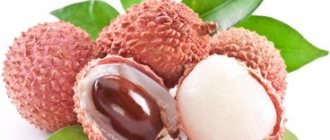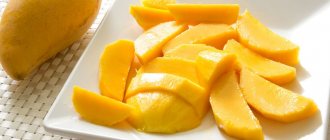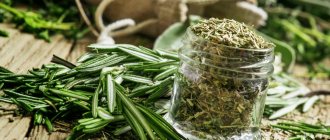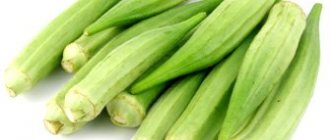Sweetie, or golden sweetie, is a relatively new fruit of the Citrus genus, which recently appeared on the shelves of stores in our country. This hybrid was created by crossing a white grapefruit with a pomelo in a California laboratory in the 1970s. In 1981, a patent was issued for the fruit, and already in 1984, Israeli breeders gave it the name “sweetie.” Breeders initially planned to develop a variety of grapefruit that was sweeter and less bitter.
Other names for sweetie: pomelite, white grapefruit and oroblanco. Sweetie plantations are located in Israel, India, Japan, China, Italy, Spain, Hawaii, America and Portugal. The plant is successfully grown indoors and is not found in the wild at all.
What does Sweetie look like?
Sweeti fruits grow on spreading trees, up to 4-10 meters in height. The leaves of the tree are a little unusual and consist of 3 parts. The middle leaf is large, and two smaller ones grow on either side of it. On plantations, trees are pruned and not allowed to grow above 2.5 meters, so that it is convenient to harvest.
Sweetie blooms with white fragrant flowers, which are collected several times in small clusters. Sweetie fruits are very similar to grapefruits, but are smaller in size. The diameter of the fruit grows to 10-12 cm. The peel with small pores, dense and green, remains this color even when the fruits are fully ripe. Sometimes the peel may acquire a yellowish tint. The flesh of the sweetie is white, almost seedless.
Origin story
In the 1970s, in an experimental California laboratory, scientists created a hybrid of white grapefruit and pomelo. Initially, it was planned to develop a variety that would be less bitter and sweeter than grapefruit. A patent for a new type of fruit was received in 1981. In 1984, Israeli breeders gave it the name “sweetie.”
Benefits of a suite
The fruits contain many useful substances, a lot of ascorbic acid, vitamin A and group B, carbohydrates, essential oils, fiber, antioxidants, enzymes, organic acids, calcium, magnesium, potassium, iron, fluorine, phosphorus, zinc, silicon. The enzymes lipase, maltase, amylase and lactase help the body break down complex substances that enter the gastrointestinal tract along with food. Sweetie improves tissue respiration, helps strengthen the nervous system, strengthens teeth and bones, and supports normal muscle and brain function. Fruits help remove harmful substances from the body and help maintain good physical shape. The aroma of the fruit's essential oil has a positive effect on the nervous system and calms and improves mood.
100 g of fruit contains only 58 kcal, which is why they are often included in dietary nutrition. There are special diets for weight loss that are developed using fruit. You need to eat sweetie in the morning or for dinner, in combination with protein foods. Vitamin smoothies and cocktails must be added to the diet. This diet, combined with physical activity, will help you lose extra pounds.
Sweetie is very useful for the human body because:
- lowers blood cholesterol;
- normalizes water balance;
- strengthens the immune system;
- normalizes blood pressure;
- accelerates tissue regeneration;
- helps get rid of apathy and depression;
- restores microflora;
- prevents the development of oncology;
- tones;
- improves digestion and metabolism;
- slows down aging;
- lowers blood sugar;
- improves vision;
- relieves swelling;
- improves attention and concentration.
The fruits have the following properties:
- antivirus
- wound healing
- antiseptic
- regenerating
- antihistamine
- antibacterial
- immunomodulatory
- anti-inflammatory
In cosmetology, the peel and pulp of the sweetie are used. The juice and essential oil well moisturize and nourish the skin, improve cell regeneration, slowing down the aging of the skin of the face and hands, and heal abrasions and wounds.
Composition and calorie content
Oroblanco has a unique composition and is low in calories. The elements it contains have a positive effect on human health.
The ripe pulp of the sweetie contains:
- vitamins A, C, E, group of vitamins B (B1, B2, B6, B9);
- micro- and macroelements;
- antioxidants;
- cellulose;
- essential oils;
- enzymes that break down fats and bad cholesterol.
The calorie content of citrus is 58 kcal per 100 grams. The ratio of BJU: proteins - 0.7 g, fats - 0.2 g, carbohydrates -9 g.
Harm
If you are trying the fruit for the first time, you should not eat too much. Try a small piece and wait a while. People with an allergic reaction to citrus fruits and intolerance to some components in the fruit should be especially careful.
Before using the oil for the first time, first place a couple of drops on your wrist. If the skin reacts normally and does not turn red or itch, you can use the oil for medical and cosmetic purposes.
Eating sweetie is not recommended for the following diseases:
- hepatitis
- enteritis
- increased acidity;
- colitis
- cholecystitis
- gastritis
- complex forms of jade;
- stomach ulcer.
Pregnant women need to carefully introduce sweetie into their diet, especially after the second trimester. If you have allergies and gastrointestinal diseases, it is better for pregnant women to refuse fruits. It is not recommended to give the fruit to children under 8 years of age.
Use in cooking
Basically, the fruits are eaten fresh, peeled and partitioned, or the fruit is cut crosswise and the pulp is removed with a spoon. In cooking, sweetie is used to prepare meat, vegetable and fruit salads, marmalade, and is added to sauces, ice cream, soufflés and drinks. Desserts and candied fruits are prepared from sweetie, which improve the taste and aroma of confectionery products. An exotic fruit salad with tomatoes, herbs and soft cheese, seasoned with olive oil, is very tasty.
The fruits are used to make jams and jams, which have an exquisite taste. If you put a slice of fruit in tea, the drink will not only become more aromatic, but also healthy. Sweets are often used to decorate various dishes. The fruits go well with poultry, seafood, vegetables and mushrooms, especially champignons. Sweetie is very popular in Thailand, where drinks, various snacks and added to dishes are made from it.
Great value
To summarize, we can talk endlessly about the fruit. Sweetie is not only a sweet, aromatic fruit from the tropics, citrus is an invaluable treasure of beneficial substances that have a beneficial effect on the human body as a whole. If you regularly consume the fruit, following all the rules, it will help improve overall well-being, increase endurance and performance, avoiding infectious and respiratory diseases, and also prevent the development of mental, depressive and unstable human conditions.
By increasing concentration, Sweetie preserves vision for people, especially those who spend a long time in front of computer monitors. A unique fruit containing special substances that neutralize the adverse effects of negative elements, with the help of which the aging process is slowed down.
However, it should be remembered that excessive abuse of citrus can lead to irreversible processes. This means that it is necessary to observe the measure, remember the restrictions and possible accompanying phenomena.
Recipes from Sweetie
Chicken salad and sweetie
Ingredients:
- 50 g crackers;
- half a sweetie fruit;
- 100 g processed cheese;
- mayonnaise;
- greenery;
- 100 g chicken fillet.
Preparation:
- Boil the meat in salted water, cool and cut into small pieces.
- If the crackers are large, cut or break each one in half.
- Cut the processed cheese into cubes.
- Peel the sweetie and cut into small pieces.
- Combine the ingredients, add mayonnaise and mix.
- Place the salad on a plate and garnish with fresh herbs.
Jelly with berries and sweetie
Ingredients:
- 2 sweetie fruits;
- one and a half glasses of frozen blackberries;
- a bag of jelly with any flavor;
- sugar.
Preparation:
- Thaw the berries and place on the stove; when they boil, remove from the heat and grind through a sieve.
- Cut the sweetie into two halves and carefully remove all the pulp.
- Squeeze the juice from the pulp and pour into the blackberries, add the jelly and heat, but do not bring to a boil. Gelatin should dissolve; you can add sugar to taste.
- Place the sweetie crusts on glasses so that they stand level.
- Pour jelly into the crusts and place in the refrigerator to cool.
- When the jelly is ready, trim off the excess top from each crust and cut into slices.
Brief characteristics of citrus
Sweetie has several other names, one of which is pomelite, which is translated from Spanish as “white gold.” The name of the fruit says a lot about itself, because the internal contents make this fruit simply priceless.
Sweetie is a green bush, it is quite tall and has spreading branches. In height, its dimensions usually reach from four to ten meters, this is if the fruit grows in the wild. But when it grows in the fields, the bush is not allowed to outgrow two and a half meters, because the crown is constantly cut off.
During flowering, the citrus bush is covered with white fragrant flowers, collected in small bunches. After a certain time, the flowers turn into round, light green fruits with yellow flesh on the inside.
Recipes for face masks from the suite
Cleansing mask
Ingredients:
- rice flour;
- bergamot oil;
- 2 tbsp. l. Sweetie juice.
Preparation:
- Grind the rice flour with a pestle and pour into a glass container.
- Add a few drops of bergamot oil and freshly squeezed juice.
- Mix the mixture thoroughly until smooth so that there are no lumps.
Cleanse the skin and apply a mask along the massage lines. Leave on for 15 minutes and rinse with warm water.
Rejuvenating mask
Ingredients:
- pulp of half a sweetie;
- olive or almond oil.
Preparation:
- Peel the pulp from the skin and films, grind into a paste.
- Add a little oil, almond or olive.
- Mix the mask well and immediately apply to your face.
The mask is left for 20 minutes, then washed off with warm water. After the mask, the skin becomes smoother and more elastic, fine wrinkles disappear.
Methods for peeling fruit
It would seem that a simple method of cleansing is accessible and simple for all fruits, but we must not forget that each citrus is special in its own way, having its own positive and negative sides. We must remember that the skin of the sweetie fruit is very thick, with a strong outer shell. Therefore, first the fruit must be thoroughly rinsed under running water in a warm or hot stream. Why is this being done? If suddenly the purchased fruit is covered with a thin layer of wax, it tends to get clogged into the pores of the peel. This means that it needs to be washed off thoroughly.
Then, several cuts (4-6) are made from top to bottom on the hard peel of the citrus with a knife, it is similar to cutting it into slices, only the cuts are made shallow so that all the juice does not leak out. Then, the peel should give in easily and separate from the inner pulp of the sweetie, but the contents of the fruit contain a small amount of essential oils, so you need to be extremely careful so that the coating does not leave marks on your hands, and hence, naturally, greasy stains on your clothes.
There is another option for peeling, it is the simplest. The pomelite is also washed with water, and then divided in half with a knife, and the pulp is removed with ordinary cutlery. There is a white film inside the sweetie fruit; you can eat citrus with it, but sometimes it adds bitterness, so it is often removed.
How to choose
To purchase a ripe and tasty fruit, it is important to remember several rules when choosing a sweetie:
- The peel of the fruit should be free of dark spots and damage, even green in color. A yellowish tint to the fruit is allowed;
- a very shiny peel indicates that the fruit was treated with wax or chemicals for longer storage;
- when pressed, the sweetie easily restores its shape;
- heavier fruits contain more pulp and juice;
- The brighter the aroma of the fruit, the sweeter it is.
Features
The appearance of the suite is quite recognizable. It is the size of a grapefruit, has a citrus aroma, and has a green, rather thick peel. The peel is shiny and smooth to the touch. The pulp is light yellow. In addition, there is a rather dense layer of cream color. Even if the fruit is small in size, it is quite heavy. Pomelite can be used for culinary purposes to create delicious desserts and salads. Usually the pulp of the fruit is used. In addition, the use of fruit can be very extravagant if you combine it with mushrooms, vegetables, seafood, and chicken.
Growing Sweetie
You can grow sweetie at home using a ripe fruit seed. The procedure consists of several steps:
- remove the seeds from the sweetie, select the largest ones;
- rinse the seeds under water to remove pulp and juice, leave to dry at room temperature for 12-24 hours;
- take a small container, for example, a salt shaker or a 50 ml glass, put a cotton swab 3-5 mm thick on the bottom;
- place the seeds on top and cover with another sponge;
- pour water into the container so that the cotton wool is well saturated with liquid, but not covered;
- place the seeds in a warm place where the temperature is 25-30 degrees. In winter, you can keep them on the windowsill, where they will receive heat from the radiator;
- water the seeds only when the top layer of the cotton sponge dries;
- in 10-14 days the first sprouts will appear and can be planted in the ground;
- take a pot with a diameter of 15 cm and lay drainage 3 cm thick. You can use a mixture of expanded clay, charcoal and pebbles. It is recommended to place 1 cm of moss or peat on the drainage;
- For the sprout, a soil mixture for citrus fruits is suitable, which you can buy at a flower shop or prepare yourself. On top of the drainage, pour a soil mixture of turf soil, humus, leaf soil and sand in a ratio of 3 to 1 to 1 to 1;
- Moisten the soil well and plant the sprouted seeds to a depth of 2-3 cm.
In summer, take the plant out into the fresh air. Watering is carried out as the soil dries. After watering, the soil is mulched with a layer of dry peat. It is preferable to water the suite with rainwater or tap water that has settled for 24 hours. From November to February it is recommended to keep the plant in a dry room where the air temperature is no higher than 10 degrees. In an apartment with central heating, the suite must be sprayed regularly using water at room temperature.
Fertilize the plant 2 times a month in the summer and 1 time every 2 months in the winter. Use complex mineral fertilizers for indoor plants. Transplantation is carried out once every 2-3 years by transferring it into a pot with a diameter several centimeters larger. The most suitable time of year for transplantation is spring. Before transplantation, drainage must be removed from the bottom of the coma. After planting in another container, the sweets are watered and sprayed with water.
Where does it grow
Although the citrus family is a recent addition by historical standards, the crop is already well established in the tropics and regions with warm, balanced climates. Currently, European and American farmers are willing to grow this hybrid, while there are also Oroblanco plantations in southern China and Japan. The hard fruits are collected in Israel and India.
Enterprising Russian gardeners and enthusiastic ladies from the CIS countries are also trying to grow a foreign plant. And it should be noted that they succeed, although we are not talking about obtaining large collections. But even a few exotic fruits grown on their own will delight home-grown growers.











